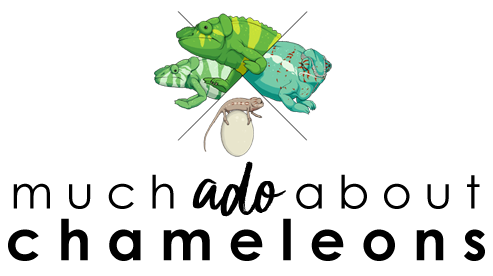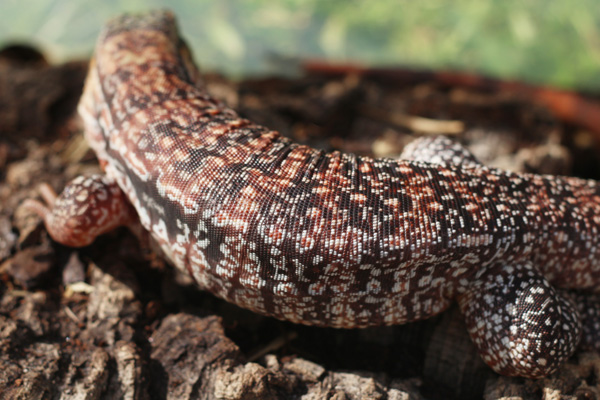 |
| Blue hornworms come in a cup with pre-prepared food and will require no additional care except emptying their poop. They grow very big very quickly! They are a favorite in my house. |
 |
| These are good example "bug bins." I cut out large air holes and hot-glue window screen to the under- side, so the bugs can breathe but can't get out. |
I currently keep crickets, superworms, and roaches (P. nivea, P. surinamers, B. discoidales, and B. fusca), and order in butterworms, hornworms, and silkworms as often as I can. This ensures that they get a well-rounded diet and never go on hunger strikes out of boredom. Most people stick to just crickets and this will often result in bored chameleons that refuse to eat. Mixing things up eliminates this possibility.
I feed the insects a well-rounded diet as well. This is called gut loading, because if your insects are full of good, nutritious food then that all goes to your chameleons when they eat. You are what you eat, after all. I feed my insects two types of food: wet and dry. The wet portion constitutes of fruits like apples, strawberries, blueberries, raspberries, oranges, and veggies like butternut squash, collar greens, mustard greens, sweet potato, and carrots. While the dry portion is comprised primarily by commercially available gut-loads, like Rapashy Super Load, Cricket Crack, and Dinofuel. These are all available online and are great products. However, there are great ingredients available to make your own dry gut load recipe, below is a quote from an excellent blog by a chameleon nutritional expert on which ingredients constitute excellent gut loading food. http://www.chameleonforums.com/blogs/sandrachameleon/75-feeder-nutrition-gutloading.html
"The dry portion (the lesser portion) of a gutload can include (blend/grind fine with a coffee grinder or food processor): spirulina; dried seaweed/kelp/dulse; bee pollen; dried alfalfa; organic raw sunflower seeds; sesame seeds; flax seed; hemp seed; poppy seeds; fennel seed, dehydrated cranberry powder; beet powder; zucchini powder; dried Mulberries; fig powder; ground dried hibiscus; ground almonds; small amounts of ground brazil nuts; small amounts of ground/choppedbeechnuts; small occassional pieces of oak leaves; small amounts of kale powder; small amounts of quality whole grain cereal / barley /oats / cracked rye /wheat germ / stabalized rice bran/ quinoa; small amounts of quality monkey, avian or ignuana food (read the ingredients, be cautious of too much Vitamin A or animal fat)."
So consider yourself warned, keeping insects almost always becomes part of what it means to keep reptiles. But it will save you money and effort by investing a little time in keeping them well housed, fed, and cared for. The health of your chameleon will benefit from it!













Are there any types of worms that can be the main diet of a chameleon? If so what would I feed those worms.....
ReplyDeleteSome great worms are silkworms, hornworms, butterworms, and superworms. But no one feeder should be more than 20-30% of the total diet, because they are also high in fat (some more than others), so other other bugs are important.
DeleteEach one will eat something a little different. Horn and silkworms will eat a commercially available mulberry leaf mush that they love, superworms can eat almost anything (like fruits and veggies), and butterworms usually will not eat anything, since they are typically kept in wine fridges to keep them in a state of hibernation.
Okay so there really is not a main feeder for a chameleon... So I would maybe give it roaches and super worms and kinda switch off. Also if i let the chameleon bask outside on my arm for a treat would eat see a bug and eat something indigestible for it?
DeleteSorry if that sentence confused you. I meant if I let it out side to bask in the sun so that the the chameleon would be more comfortable with me, would it not know any better and eat a bug indigestible for it?
ReplyDeleteIt could, but it's probably unlikely. You never know though, he could snatch a wasp out of the air and hurt his mouth, etc., but if you take him outside to bask in a screen cage he should be safe but still get all the benefits of sunshine. Birds (even small birds like sparrows) will try to eat a chameleon, so it's a good idea to never leave them out in the open if you're not standing right by them, so they are usually safer in cages anyway.
DeleteGreat post!! Thanks for sharing!!
ReplyDeleteVIBRATING FEEDER MANUFACTURER
This comment has been removed by the author.
ReplyDeleteBy preventing pests from reaching your plants, you can avoid the damage they cause. And in cases where you only see a few pests, physically removing them can often keep the problem under control.
ReplyDeletehttps://10pestskiller.com/best-ultrasonic-dog-repeller/
Hi, best wishes to you and your very nice blog,
ReplyDeleteThere ar 3 ways to get feeder insects: breeding them yourself, shopping for them or catching them from the wild. after you catch feeder insects within the wild, you'll be able to usually feed them to your chameleon directly as you'll most likely not catch several directly. jasa anti rayap
ReplyDeleteดูหนัง After the Rain หลังฝนตก คุณคิดถึงใคร (2018) ดูหนังออนไลน์แสนสนุกที่นี่สิ
ReplyDeletehttps://www.doonung1234.com/